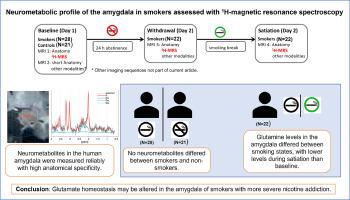NeuroImage ( IF 5.7 ) Pub Date : 2024-01-24 , DOI: 10.1016/j.neuroimage.2024.120525 Colette A Steinegger , Zoelch Niklaus , Andreas Hock , Anke Henning , Etna JE Engeli , Christopher R Pryce , Erich Seifritz , Marcus Herdener , Lea M Hulka

|
Tobacco smoking is one of the main causes of premature death worldwide and quitting success remains low, highlighting the need to understand the neurobiological mechanisms underlying relapse. Preclinical models have shown that the amygdala and glutamate play an important role in nicotine addiction. The aims of this study were to compare glutamate and other metabolites in the amygdala between smokers and controls, and between different smoking states. Furthermore, associations between amygdalar metabolite levels and smoking characteristics were explored.
A novel non-water-suppressed proton magnetic resonance spectroscopy protocol was applied to quantify neurometabolites in 28 male smokers (≥15 cigarettes/day) and 21 non-smoking controls, matched in age, education, verbal IQ, and weekly alcohol consumption. Controls were measured once (baseline) and smokers were measured in a baseline state (1–3 h abstinence), during withdrawal (24 h abstinence) and in a satiation state (directly after smoking). Baseline spectroscopy data were compared between groups by independent t-tests or Mann-Whitney-U tests. Smoking state differences were investigated by repeated-measures analyses of variance (ANOVAs). Associations between spectroscopy data and smoking characteristics were explored using Spearman correlations.
Good spectral quality, high anatomical specificity (98% mean gray matter) and reliable quantification of most metabolites of interest were achieved in the amygdala. Metabolite levels did not differ between groups, but smokers showed significantly higher glutamine levels at baseline than satiation. Glx levels were negatively associated with pack-years and smoking duration.
In summary, this study provides first insights into the neurometabolic profile of the amygdala in smokers with high anatomical specificity. By applying proton magnetic resonance spectroscopy, neurometabolites in smokers during different smoking states and non-smoking controls were quantified reliably. A significant shift in glutamine levels between smoking states was detected, with lower concentrations in satiation than baseline. The negative association between Glx levels and smoking quantity and duration may imply altered glutamate homeostasis with more severe nicotine addiction.
中文翻译:

使用 1H 磁共振波谱评估吸烟者杏仁核的神经代谢特征
吸烟是全世界过早死亡的主要原因之一,戒烟成功率仍然很低,这凸显了了解复发背后的神经生物学机制的必要性。临床前模型表明杏仁核和谷氨酸在尼古丁成瘾中发挥着重要作用。这项研究的目的是比较吸烟者和对照组以及不同吸烟状态之间杏仁核中的谷氨酸和其他代谢物。此外,还探讨了杏仁核代谢物水平与吸烟特征之间的关联。
应用一种新颖的非水抑制质子磁共振波谱方案来量化 28 名男性吸烟者(≥15 支/天)和 21 名不吸烟对照者的神经代谢物,这些对照的年龄、教育程度、语言智商和每周饮酒量相匹配。对照组测量一次(基线),吸烟者在基线状态(1-3小时戒烟)、戒断期间(24小时戒烟)和饱腹状态(吸烟后立即)进行测量。通过独立t检验或 Mann-Whitney-U 检验比较组间的基线光谱数据。通过重复测量方差分析(ANOVA)研究吸烟状态差异。使用 Spearman 相关性探讨了光谱数据和吸烟特征之间的关联。
在杏仁核中实现了良好的光谱质量、高解剖特异性(98% 平均灰质)和大多数感兴趣代谢物的可靠定量。各组之间的代谢水平没有差异,但吸烟者在基线时的谷氨酰胺水平明显高于饱腹感。 Glx 水平与吸烟年限和吸烟持续时间呈负相关。
总之,这项研究首次深入了解吸烟者杏仁核的神经代谢特征,具有高度的解剖特异性。通过应用质子磁共振波谱,对不同吸烟状态和非吸烟对照的吸烟者的神经代谢物进行了可靠的定量。检测到吸烟状态之间谷氨酰胺水平的显着变化,饱腹感中的谷氨酰胺浓度低于基线。 Glx 水平与吸烟量和持续时间之间的负相关可能意味着谷氨酸稳态的改变和更严重的尼古丁成瘾。



























 京公网安备 11010802027423号
京公网安备 11010802027423号